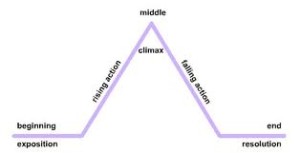The most common plot diagram is this, the one you have probably seen many, many times:
There’s others: the snowflake, the hero’s journey (this is a good one), and this one combines a few classic ideas about plotting. These are wonderful tools.
However, I’m usually a write-by-the-seat-of-my-pants kind of writer. I have only pre-plotted one book (for NaNoWriMo, which was the only way I could face 50K words of story in one month). Then, I began writing a cozy mystery. I had to plan, plot and organize to build the puzzle.
I’ve got some great books on my shelf that have helped me enormously (How to Write Killer Fiction, and Don’t Murder Your Mystery for example). But I really wanted that picture worth a thousand words that would help me through this brave new world of mystery writing.
I looked. And when I look, I look. I’ll wade dozens of pages deep into Google if I really, really want to find something. I found great diagrams like those mentioned above, but much of what I found were variations on the classic diagram. Turns out the diagram I was looking for was in my head.
I began with the idea of a string of pearls (you see that by sizing them ever larger and then tapering off, I am still paying homage to the classic diagram). For me, however, the pearls are the metaphor for the core mystery, that is, the direct line of clues set up before, during, and after the murder that leads the sleuth to uncover the killer, A to Z. The pearls do not represent either the red herrings (people or clues) or the personal arc of the sleuth. Those are represented instead by the spiral around the pearls and the waves acting as the “string” in the string of pearls respectively. Secondary characters and false clues, shown as dots, are then distributed along the spiral. In most cozies, the story of the protagonist-sleuth builds right along with the mystery, and (one hopes) will entice the reader to see what happens next to our intrepid hero/ine – which is why the red wave ends up in a question mark with an arrow, since it’s a darn good idea to leave a little cliffhanger about what’s next for him or her.
Oh yes, the BOOMS. One’s for the confrontation between sleuth and perp; the other is to show that often, the sleuth’s personal life has a blowup just before he/she is thrust into the climactic scene where all is discovered, just to make sure the reader is invested in the character on both levels, the personal and the puzzle. The sleuth rises from the battle, maybe bruised but transformed, the mystery is explained, and the stage gets set for the next adventure.

See? If you have your own version of a plot diagram, send it along! The best will be posted.
Posted in On Writing, Uncategorized and tagged cozy mystery, mystery plotting
